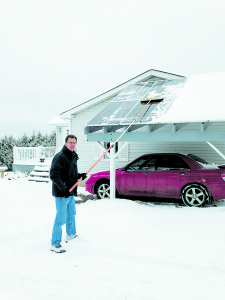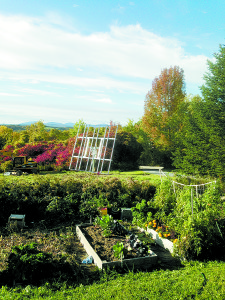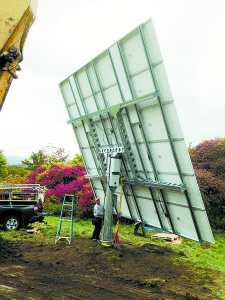By George Harvey
To have a functional solar system, it is necessary to have the panels mounted on hardware specifically made for the purpose. There are many choices available for the mounting hardware. Under some circumstances, the choices are rather simple, but certainly not always. There are many types of solar mounts and different reasons for each.

Utility-scale solar system in Vermont. These systems do not usually come with hot air balloons. Photo courtesy of RBI Solar.
Rooftop solar is perfect in many places. Fixed ground-mounted systems are similar, except that the choices of direction and angle of mounting can be optimized with an appropriate rack, instead of being dictated by the pitch and orientation of a roof. By contrast, the more complicated and expensive tracking systems move the panels and keep them aimed at the sun through the day, delivering more energy, as much as 40% in optimally sited systems.
Kirsta Tortorice, whose father, Bob Tortorice, is known to many of our readers as a builder of high-performance homes, recently wrote a thesis dealing with solar mounts in some depth, “Utilization of Contaminated Land for Renewable Energy Projects: Constructing Solar Farms on Capped Landfills in Massachusetts.” Though the paper deals with special situations, Ms Tortorice’s general comparisons are useful. She had this to say, “Fixed tilt is when the panels are installed at a permanent angle that has been designed to receive the most solar radiation throughout the year, based on variables such as slope, latitude, and direction. Sun-tracking technologies, or azimuth, tracking is the technology that allows the PV panels to follow the optimal amount of sun exposure over the course of the day.”
There is a distinction to be made between fixed systems that are mounted at a permanent angle, and those that allow the tilt of the panels (angle up and down) to be adjusted seasonally. Adjustable mounts can produce efficiency gains but are also valuable because, in the winter, they are at a steeper angle and snow tends to slide off easily.
A similar distinction is made for tracking systems. Of these, Ms Tortorice wrote, “Single axis trackers are mounted on an axis horizontal to the ground, which lets the panels rotate based on the sun’s location during the day. Double axis trackers are slightly different because they allow the panels to follow the sun’s position in the sky, as well as the east and west movement. This allows the panels to adjust no matter what time of day or season during the year. Both of these technologies are effective at maximizing electricity output but tend to be more expensive than the fixed tilt technologies.”
To some extent, the nature of the mounting system is dictated by the site. Chris Milner, of Milhouse Technologies, gave some pointers. Where there is good exposure to the sun only during the middle of the day, the low initial cost of fixed systems is important. Where there is a lot of exposure to the rising and setting sun, trackers can gather sunlight during all hours, showing its advantage.
We might look at some examples of mounting systems. Matt Reiss, of Butternutts, New York, has a system that illustrates the sort of fixed system that is put on rooftops and in yards and fields. There is no roof, but there are rafters with purlins screwed across the top. The panels are bolted to the purlins from underneath. The system functions as a car port, though there is no actual roofing. It is made of wood anchored in concrete. With the exception of those pieces of hardware specific to solar electric systems, the hardware came from ordinary hardware stores. The panels are fixed at a 33º angle toward the south. It is a home-built system, but very functional.
When mounting solar panels directly on a roof, it is wise to use professionally designed and manufactured equipment. Anyone who wishes to consider installation might do well to take a look at the hardware made by Unirac Solar Mounting Solutions, for one example of the mounting systems. The fixed-mounted “racking” is used at sites ranging from small residential rooftop installations to utility-scale ground mounts.
Our editor, Nancy Rae Mallery, has a pole-mounted system that does not track but can be adjusted seasonally. Such systems can be over 5% more efficient than nonadjustable fixed systems.
There is a nice example of a tracking system that powers a residence in Bradford, Vermont. It was installed by O’Meara Solar of East Orange, VT using a tracker from AllEarth Renewables, of Williston. The tracker keeps the panels pointed directly at the sun, allowing them to get the greatest exposure and operate at the greatest efficiency. This system is 6.84 kilowatts and based on performance since October should produce about 10,000 kilowatt hours per year, reducing his electric bill to about $32 per month.
Watch for more examples and other mounting systems that are not mentioned here that are available and made in the Northeast in future issues of Green Energy Times.











Leave a Reply